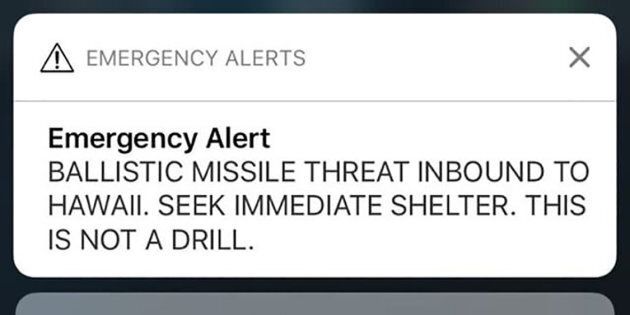
HONOLULU — A former Hawaii state worker who sent a false missile alert last month said Friday he's devastated about causing panic but was "100-per-cent sure'' at the time that the attack was real.
The man in his 50s spoke to reporters on the condition that he not be identified because he fears for his safety after receiving threats.
He says an on-duty call that came in on Jan. 13 didn't sound like a drill. However, state officials say other workers clearly heard the word "exercise'' repeated several times.
"Immediately afterward, we find out it was a drill and I was devastated. I still feel very badly about it,'' he said. "I felt sick afterward. It was like a body blow.''
He's had difficulty eating and sleeping since, he said: "It's been hell for me the last couple weeks.''
The Hawaii Emergency Management Agency fired him after the incident.
Poor performance
The man's superiors said they knew for years that he had problems performing his job. The worker had mistakenly believed drills for tsunami and fire warnings were actual events, and colleagues were not comfortable working with him, the state said.
His supervisors counselled him but kept him for a decade in a position that had to be renewed each year.
The ex-worker disputed that, saying he wasn't aware of any performance problems.
While starting a Saturday shift at the emergency operations centre in a former bunker in Honolulu's Diamond Head crater on Jan. 13, the man said, a co-worker took a phone call over the U.S. Pacific Command secure line that sounded like a real warning, he said.
"When the phone call came in, someone picked up the receiver instead of hitting speaker phone so that everyone could hear the message,'' he said.
The man said he didn't hear the beginning of the message that said, "exercise, exercise, exercise.''
"I heard the part, 'this is not a drill,''' he said. "I didn't hear exercise at all in the message or from my co-workers.''
Vague checklist
Federal and state reports say the agency had a vague checklist for missile alerts, allowing workers to interpret the steps they should follow differently. Managers didn't require a second person to sign off on alerts before they were sent, and the agency lacked any preparation on how to correct a false warning.
Those details emerged Tuesday in reports on investigations about how the agency mistakenly blasted cellphones and broadcast stations with the missile warning.
It took nearly 40 minutes for the agency to figure out a way to retract the false alert on the same platforms it was sent to.
"The protocols were not in place. It was a sense of urgency to put it in place as soon as possible. But those protocols were not developed to the point they should have,'' retired Brig. Gen. Bruce Oliveira, who wrote the report on Hawaii's internal investigation, said at a news conference.
Hawaii Emergency Management Agency Administrator Vern Miyagi resigned as the reports were released. Officials revealed that the employee who sent the alert was fired Jan. 26. The state did not name him.
The protocols were not in place. It was a sense of urgency to put it in place as soon as possible. But those protocols were not developed to the point they should have.Brig. Gen. Bruce Oliveira
The agency's executive officer, Toby Clairmont, said Wednesday that he stepped down because it was clear action would be taken against agency leaders after the alert.
Another employee was being suspended without pay, officials said.
The incident "shines a light'' on the state's system failures, the man who sent the alert said, adding that he believes the federal government should handle such alerts.
Testing of the alert system began in November and protocols were constantly changing, he said. "As far as our level of training was concerned, I think it was inadequate,'' he said.
Hawaii state Department of Defence spokesman Lt. Col. Charles Anthony declined to comment on what the former worker said.
Officials said the man refused to co-operate with state or federal investigations beyond providing a written statement. He wasn't trying to impede any investigations, he said: "There really wasn't anything else to say.''
___
This story has been corrected to say a co-worker took the call, not the man who sent the alert.
Also on HuffPost:
